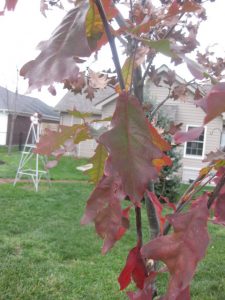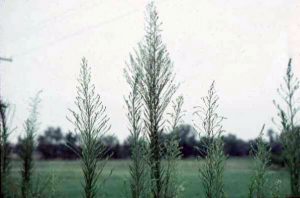Q. I have a white oak tree that lost about half of its leaves to a varmint. I’m guessing June bugs that were in a bunch about 15 feet away. The tree did not put out any new growth except late in the summer on the end of the tallest limb. Meantime, a new tree sprung up. I’ll include some pictures that will show the leaves and their color. I have no idea what flavor this oak is. – G.F.
A. It is unlikely that June bugs (June beetles) would cause damage; they are dramatic when they swarm but harmless. Your tree is one of the white oak group, likely white oak or a hybrid. There are many possible culprits and possibly more than one that could be causing the early loss of leaves. The fact that the leaves are exhibiting what appears to be early fall color before they drop points to either trunk injury near the base of the tree and/or root stress.
When you say that a new tree sprung up, do you think this is a new seedling or might this be a new trunk emerging from the base of the existing tree? The latter is common when there is trunk injury. Trunk damage could be from rodents or mechanical injury such as “mower blight” – weed whips, twine or wire left on the trunk at planting time, etc.
For more specific diagnostic help, you might try taking some additional photos of the overall tree and close-up of the trunk and either take them to your local county office of Purdue Extension (https://extension.purdue.edu/about/state-headshots/county-office.html) or submit a sample the Purdue Plant and Pest Diagnostic Lab (www.ppdl.purdue.edu).
Q. My daughter and I noticed this weed last year and were told it is called “mare’s tail.” We have seen a lot more of it this year. We have used Roundup weed killer to no avail. Then we tried a “home remedy” spray – again, to no avail. We have had to pull up this weed, exposing the root to the sun to dry, but this is a never-ending job as the weed spreads so rapidly. We would thank you for any information on how to get rid of these hateful weeds! – R.J.
A. You are not alone! Marestail, also known as horseweed, has developed resistance to glyphosate, the active ingredient in RoundUp. Although it is native throughout North America, marestail has become quite weedy due to its ability to produce and spread large quantities of seed. An individual plant can produce up to 200,000 seeds! And the seeds have a bristly-hairy appendage that facilitates being distributed by wind.
In the northern parts of Indiana, marestail is typically a winter annual (seed germinates in the fall, overwinters as a leafy rosette, then flowers and sets seeds in spring.) In southern areas of Indiana, it is more typically a summer annual (spring germination with summer flowering and seed.) The plants can reach up to 6 feet tall.
The herbicides that provide good control of marestail are not generally available or practical for home gardens and landscapes. In the yard and garden, the most successful control strategy is preventing the plants from going to seed. Mowing, hoeing and digging the plants before they flower is key. Small, young plants will be easier to control. Mulching might help suppress germination of existing seeds.
Although aimed at agronomic production, Purdue Extension publication ID-323, Biology and Management of Horseweed, has additional information of interest to home gardeners. https://www.extension.purdue.edu/extmedia/gwc/gwc-9-w.pdf

